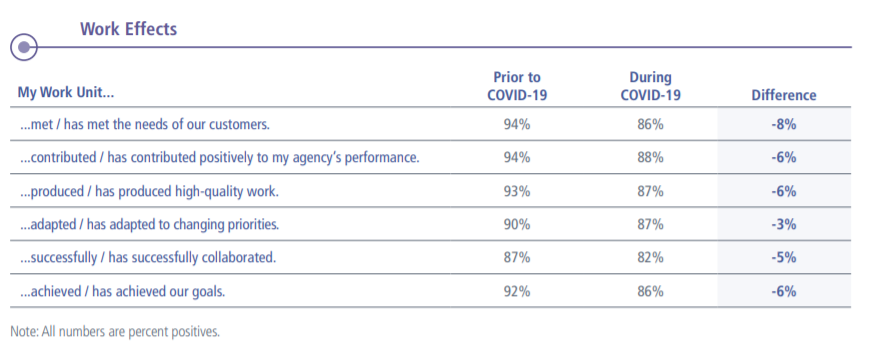
2020 FEVS: What we learned about the federal workforce during COVID-19
New data from the most recent Federal Employee Viewpoint Survey shows how agencies expanded telework during the pandemic to parts of the workforce where such ar...
The COVID-19 pandemic forced agencies to expand or add new workplace flexibilities, and recent data from the 2020 Federal Employee Viewpoint Survey sheds new light on just how often the workforce used those programs.
OPM shortened the 2020 employee viewpoint survey and included new questions to gauge the pandemic’s impact on federal employees. The data, the agency has said, may inform how the government plans for future emergencies or expands or extends existing flexibilities for federal employees in the future.
No surprise, agencies expanded their telework programs in ways they hadn’t before during the pandemic.
Just 3% of the federal workforce teleworked every day before the pandemic, according to the 2020 FEVS.
At the peak of the pandemic, 59% of employees teleworked daily, and 47% worked remotely every day at the time they responded to the OPM survey, likely last fall.
The data also shows how agencies expanded telework to employees who previously couldn’t take advantage of the program before the pandemic began.
According to 2020 FEVS, 24% of federal employees did not telework before the pandemic because they had to be physically present on the job.
But by the pandemic’s peak, 16% of the federal workforce said they did not telework because they had to be physically present for their job. That number ticked up slightly last fall, when 18% of employees said they didn’t telework for that reason.
Agencies also approved more employees for telework than they had previously. Before the pandemic, 19% of the workforce said they weren’t approved to telework even though their job was conducive to remote work. By the peak of the pandemic, just 2% of employees said they didn’t telework because they didn’t have approval, with the number increasing to 4% by the fall.
Nearly one-third of federal employees haven’t been to their work sites at all during the pandemic, while 17% of the workforce has been on site the entire time, according to the 2020 FEVS. Another 24% of employees have been at their worksites less than a quarter of the time during the pandemic.
Federal employees are overwhelmingly satisfied with telework, according to the latest FEVS results. Of those who can telework, 82% said they were very satisfied or satisfied with their agency’s program. Just 5% said they were dissatisfied, and 12% were neutral.
OPM also said it sees a correlation between telework participation and employee engagement. According to the agency, federal employees who telework at least three or four days a week were more engaged than those whose job prevents them from working remotely, 76% compared to nearly 63%.
Nearly one-third of the federal workforce used sick leave because of pandemic
Agencies made a broader variety of leave available to federal employees in 2020 to help them through the pandemic.
Nearly one-third, or 30%, said they used sick leave at some point last year because of the pandemic.
Many agencies allowed employees to use weather and safety leave in situations where they couldn’t telework and couldn’t report to their work site because of the pandemic. About 10% of the federal workforce used weather and safety leave for those reasons, according to the 2020 FEVS.
And 37% of employees used annual leave at some point because of the pandemic. Nearly half, or 49%, said they didn’t use leave last year for pandemic-related reasons.
Those who did use leave because of the pandemic did so on a relatively infrequent basis, according to the FEVS data. About 82% said they used leave for a quarter or less of their total work time last year.
About 3% of the workforce used leave for all of their work time, according to the OPM survey.
Employee perceptions about work achievements dip
While many federal employees gave their agency’s leaders high marks for the flexibilities they implemented for the pandemic, COVID-19 clearly had an impact on their ability to accomplish their work.
For example, 88% of employees said their work unit contributed to their agency’s performance during the pandemic, compared to 94% before COVID-19.
Employees’ perceptions of their work unit’s accomplishments also changed during the pandemic. About 86% of the workforce said their work unit has achieved their goals during the pandemic, again, a 6% drip from prior to COVID-19.

Nearly two-thirds, or 61% of federal employees, don’t have child care duties, but for the rest of the workforce, those responsibilities at least partially impacted their work.
About 38% said school closures or changes were extremely or very disruptive to their ability to do their work, and another 23% said they were somewhat disruptive.
To manage these disruptions, 12% of employees used an alternative work schedule, while 11% took paid leave to balance their child care responsibilities.
A majority, or 86% of federal employees, did not change their schedules due to the pandemic. About 11% started an alternative work schedule last year, according to the 2020 FEVS.
The most recent employee viewpoint survey doesn’t account for the new emergency paid leave program the Biden administration formally launched last week, which allows federal workers to take up to 15 weeks of paid leave to handle child or elder responsibilities during the pandemic.
Copyright © 2024 Federal News Network. All rights reserved. This website is not intended for users located within the European Economic Area.
Nicole Ogrysko is a reporter for Federal News Network focusing on the federal workforce and federal pay and benefits.
Follow @nogryskoWFED





